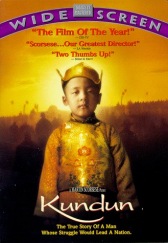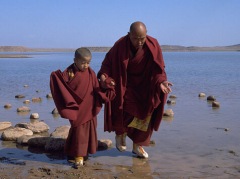|
Kundun
|
| |
 |
USA, 1997. Rated PG-13. 128 minutes.
Cast:
Tenzin Thuthob Tsarong, Gyurme Tethong, Tulku Jamyang Kunga Tenzin, Tenzin
Yeshi Paichang, Tencho Gyalpo, Tsewang Migyur Khangsar, Geshi Yeshi Gyatso,
Sonam Phuntsok, Lobsang Samten, Gyatso Lukhang, Jigme Tsarong, Tenzin
Trinley, Robert Lin
Writer: Melissa Mathison
Original music: Philip Glass
Cinematography: Roger Deakins
Producer: Barbara De Fina
Director: Martin Scorsese
LINKS
|
 estern
films that explore the mysteries of Far Eastern religions and culture, like
Seven Years in Tibet or Little Buddha, are often told from the
point of view of a Western journeyer with whom the audience can identify, using
him as a familiar anchor in a bewilderingly unusual world. But it is not a Westerner
who goes on a journey in Kundun—there are no Europeans in the film
at all. Unlike Seven Years in Tibet, Scorsese tells the story of the
Chinese occupation of Tibet in the 1950s from the point of view of the Dalai
Lama himself, with his religious faith and beliefs mixing freely with "objective"
reality. It is the Dalai Lama who goes on a journey—his life is the journey.
The only concession Scorsese makes to his Western audience is the use of English
as the film's primary language.
estern
films that explore the mysteries of Far Eastern religions and culture, like
Seven Years in Tibet or Little Buddha, are often told from the
point of view of a Western journeyer with whom the audience can identify, using
him as a familiar anchor in a bewilderingly unusual world. But it is not a Westerner
who goes on a journey in Kundun—there are no Europeans in the film
at all. Unlike Seven Years in Tibet, Scorsese tells the story of the
Chinese occupation of Tibet in the 1950s from the point of view of the Dalai
Lama himself, with his religious faith and beliefs mixing freely with "objective"
reality. It is the Dalai Lama who goes on a journey—his life is the journey.
The only concession Scorsese makes to his Western audience is the use of English
as the film's primary language.
Via opening captions, we learn right off that "Dalai Lama" means "Ocean of
Wisdom," a human manifestation of the Buddha of Compassion, put on earth to
love all living things. He is sometimes referred to simply as "Kundun," or "The
Presence." When he dies, he is reborn, as are all things according to Buddhist
beliefs. The reborn Dalai Lama must be found with all speed. When we meet the
fourteenth reincarnation of the Dalai Lama in a remote northeastern region of
Tibet in 1937, he is a two-year-old named Lhamo Dhondrub.

Tulku Jamyang Kunga Tenzin and Lobsang Samten in Kundun |
With Roger Deakins' camera often adopting the Dalai Lama's perspective, we
learn about the world as he does. His childhood innocence, in which he regards
Tibet's army of 5,000 troops as vast, is mercilessly stripped away. Following
World War Two, Mao Tse-Tung and the Communist Party come violently to power
in China, and in 1949 Mao declares Tibet to be a Chinese province. Troops and
settlers occupy the country in order to free it of "imperialist" influences,
overwhelming pitifully inadequate resistance. Kundun then sketches out
the next ten years, during which the Dalai Lama steadfastly attempts to maintain
Tibet's independence while seeking a non-violent solution. Because, as he is
presented in the movie, the Dalai Lama is the living embodiment of the nation
of Tibet, the corruption of his innocence is the corruption of Tibet's innocence,
and the violation of Tibet's sovereignty is an assault on his soul. When the
Dalai Lama finally goes into exile, it is the exile of Tibet's identity as a
nation.
As Peter Gabriel, composer of the score for The Last Temptation of Christ,
once observed, Scorsese is a very musical director. He marries music to images
better than any other director, and like his camerawork, his soundtracks are
a dynamic component of his films, more than just atmospheric decoration or a
tool for cheap manipulation. In Kundun, Philip Glass's hypnotic blending
of traditional Tibetan chanting and music with repetitive orchestral arrangements
communicates almost everything we need to know in the mostly non-verbal early
scenes. Visually, Scorsese is always experimenting. To accentuate moments of
insight, discovery, or change, Scorsese replaces camera zooms with three or
four quick cuts, each slightly closer to or further away from the subject being
observed.
Even Scorsese's most beautiful films have a brutal energy, whether overt or
implied. However, in Kundun Scorsese depicts little of the violence perpetrated
by the Chinese army because we see only what the Dalai Lama directly witnesses.
Rather, Scorsese shows us the murder and destruction through the Dalai Lama's
visions and dreams. In these sequences, for example, jets of blood spew into
a crystalline koi pond, and the Dalai Lama becomes an insignificant speck in
an ocean of red-robed corpses as the camera gradually pulls away.
Though a meditative, introspective film, Scorsese's distinctive techniques
cause Kundun to pulse with life under its calm surface. He has made a
film that is spiritually beautiful, in addition to being literally so, with
its lavish costumes and spectacular vistas (which are actually Moroccan, with
some digital effects and second unit work in Idaho and British Columbia). The
result is a hallucinogenic affirmation of faith similar to Scorcese's treatment
of the life of Jesus in The Last Temptation of Christ. Kundun
may be less controversial (except perhaps to the current Chinese government,
which still lodges official complaints whenever U.S. officials meet with the
Dalai Lama), but it is equally compelling.
Review
© October 2003 by AboutFilm.Com and the author.


